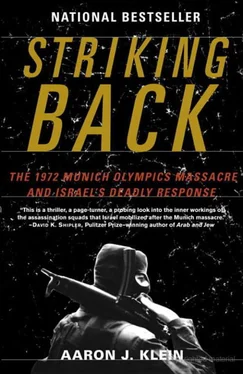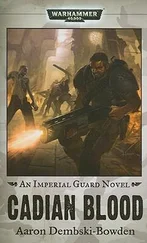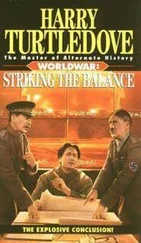Everyone wanted details, but the Facha chief wouldn’t say another word. The committee members knew his announcement related to two of the three terrorists that had left the scene of the massacre alive. The Mossad had reported that the third man, Adnan Al-Jishey, had died of heart failure sometime in 1978–1979 in the Persian Gulf state of Dubai. His natural death, they were told, was caused by a genetic heart mutation. Now they learned that the circle had been closed—Jamal Al-Jishey and Mohammed Safady had also expired. All of the perpetrators of the murder had paid the price. The news was sent up the chain of command to Prime Minister Menachem Begin. Nothing was leaked to the press.
Khaled Abu-Toameh, an Israeli Arab journalist, had certainly not heard about the meeting. On July 31, 1992, he published an interview with Jamal Al-Jishey. The glaring headline over the front-page article in the weekly Jerusalem was: “Mossad Still Trying to Kill Me.” Al-Jishey, forty, lived in Tunis and continued to abide by strict security precautions. “I’m sure the Mossad is still looking for me,” he said. “As far as the Israelis are concerned, the case is not yet closed. The Mossad will try to kill me until the day I die.”
An additional testament to Al-Jishey’s sound health came in 2000, with the release of the Academy Award–winning documentary One Day in September. In Arthur Cohen’s movie, Al-Jishey sits for long interviews, his face blackened and his form distorted by a hat.
The fate of Mohammed Safady, the third terrorist to leave Munich alive, remains ambiguous, although most analysts tended to believe he had been killed. Some members of the intelligence community intimated that his death had come at the hands of the Lebanese Christian Phalangists—Israel’s allies—as a gesture of sorts to the Israeli Mossad. The Jerusalem article supported that notion, noting that Jamal Al-Jishey was the last man standing from the massacre. Tawfiq Tirawi disagrees. In a conversation we held in his Ramallah office in July 2005, Tirawi confirmed that he and Safady were close friends and that Safady was alive and well. “As alive as you are,” Tirawi said, smiling playfully, refusing to add details. “The Israelis could still harm him,” he explained.
Thought to be dead, Jamal Al-Jishey and Mohammed Safady were officially removed from the Israeli hit list in 1986, at the close of the meeting held in the Seminary. The permanent members of the committee were the head of Target Branch of Military Intelligence, a lieutenant colonel; the head of the Terror Division in Military Intelligence, a colonel; the head of the Intelligence Gathering Division in Military Intelligence, a colonel; the head of a branch of Unit 8200, Israel’s high-quality NSA equivalent, a lieutenant colonel; and the host of the meeting, the head of the Facha division at the Mossad, the equivalent of a major general. “The Mossad member was always someone serious, a former combatant, very mission-oriented,” one of the regular members told me. “The list itself had a maximum of fifteen slots. Over the years, two or three names were taken off the list and replaced by others after it became clear that the person was not involved in Munich. Others were added when information implicated them in the attack. Some kept their borderline status the whole time.”
The meetings went straight to the point. “We addressed only new intelligence. Usually one of the agencies had new information about a wanted man, something like upcoming travel plans. Once we all agreed that the information was credible, we shifted gears, becoming more focused, active, and secretive. The Mossad would then bring in Caesarea’s chief intelligence officer. He and his staff officers would organize and collect all of the intelligence information, including pictures of the target, and the target buildings, from the ground and from above. As the plans progressed, the attention to detail increased. At this stage we were all in operation mode.”
The head of the Mossad brought the finalized plan to the Heads of Agencies Committee. There, the heads of the Mossad, Shabak, and Military Intelligence, frequently joined by the military aide to the prime minister, could debate the necessity or timing of a mission, arguing for its suspension or delay. Only the prime minister had veto power. The need for these meetings was purely practical. The 1995 assassination of Fatkhi Shkaki illustrates their utility.
As head of the Palestinian Islamic Jihad, a small, extreme terrorist organization, Fatkhi Shkaki proved himself quite able. He was a strong leader with a firm grip on every aspect of his organization. In January 1995, after a deadly attack at Beit Lid junction east of the Israeli city of Netanya, it was decided to begin planning his assassination. The goal was preventive—it was assumed that eliminating the capable Shkaki would keep Islamic Jihad out of action for a year or two.
Prime Minister Yitzhak Rabin authorized the commencement of operational assassination plans. For roughly two months the Mossad collected intelligence on Shkaki, filling his already fat file with even more information. The intensive intelligence-gathering effort bore fruit. Shkaki could be killed in early summer 1995. They presented their plan and the proof of his guilt to the agency heads.
Uri Saguy, head of Military Intelligence, was dead set against the Mossad plan. After the meeting he spoke with Prime Minister Rabin, explaining that the assassination, which was to be carried out in the heart of Damascus, would damage the already shaky, ongoing Israeli-Syrian peace negotiations. Saguy asked that the operation be moved to a different locale, somewhere neutral, a place that would not impact the chance of peace. Rabin accepted his argument. He instructed the Mossad to change their plans.
Shkaki, a terrorist with the blood of dozens of Israelis on his hands, a man with a bulldozer-like ability to get things done in the world of organized terrorism, lived in Damascus, and rarely left. Shabtai Shavit, the head of the Mossad, and others in the organization were forced to accept Rabin’s decision. Their plan, tailor-made for Damascus and ready to be executed at a moment’s notice, had to be shelved, perhaps indefinitely.
The Mossad continued to collect intelligence on Shkaki, learning his routine and paying special attention to his travel plans. They needed a clean plan, something that would leave no Israeli prints. They learned that when Shkaki did leave Damascus, it was to one of two places—Tehran, on a direct flight, or Libya, which he reached either by ferry, via Malta, or plane, via Tunis. The Mossad chose the island of Malta. Saguy and the prime minister were pleased. All they had to do was wait. Once Caesarea was given the go-ahead, operations were frozen eight different times; once, out of a sudden concern for the assassins’ well-being just thirty seconds before they pulled the trigger. On October 28, 1995, Shkaki was shot dead outside the Diplomat Hotel in Malta. His killers, two combatants from Kidon, Caesarea’s assassination wing, fled the scene on a motorcycle, and left the country immediately.
Israeli prime ministers had the power to take someone’s life with a nod of their head. The way those decisions were addressed often revealed a great deal about a leader’s character. They were far from the public eye when they met the heads of Mossad and they knew that nothing they said or did would be leaked to the public. The prime minister could, and did, act according to his or her conscience and worldview. Rabin was a ponderer, asking pesky and prying questions. He was pedantic, had a phenomenal memory, and demanded solid answers. He often sent Military Intelligence and Mossad officials packing. “It hasn’t matured,” he’d say in his slow baritone, leaving everyone to wonder if the timing was poor politically, the indictment insufficiently strong, or the man insufficiently guilty.
Читать дальше












